Musicians have long acknowledged the harmonic resourcefulness and techniques of Debussy. There are few who question his significant contributions to the expansion of and subsequent break with functional tonality that marked the beginning of this century.1 On the other hand, it is quite evident that Debussy disdained learned contrapuntal devices and even expressed reservations about Bach's music, such as the following words written to his publisher:
Never edit the Sonatas for violin and piano of J.S. Bach on a rainy Sunday. I've just finished revising the above, and I feel the rain inside. When the old Saxon cantor has no ideas, he sets off on anything and is truly merciless. In short, he is unbearable except when he is admirable. That's really something, you'll say.2
That Debussy may have deplored contrapuntal devices per se does not preclude the incorporation into many of his works of subtle forms of melodic or motivic combinations, counterlines, and countertextures that involve the play of lines in what may be described as a kind of unobtrusive, idiomatic counterpoint. The opening of Reflets dans L'eau, from Images I, 1905, illustrates one such phase of the counterpoint to which I refer. (See Example 1.)
Ex. 1. Debussy, Reflets dans L'eau, mm. 1-2.

Counterpoint occurs here in the form of two simultaneously stated but contrasted motivic gestures, the one represented by the rising pattern of three-note sonorities (triads and trichords) stated in the upper voice, the other formed by the descending tenor figure, A-flat—F—E-flat. Both of these elements are central to the unfolding of the piece, especially the former. Voice-leading is also implied by the succession of treble sonorities in measure 1, which constitutes a form of modified planning. Despite the absence of explicit step connections in the note-to-note movement of the sonorities, an implicit yet clearly audible step pattern emerges in the form of a descending line, D-flat—C—B-flat  by virtue of the high or low position of each of the three notes in the sonorities in which the notes occur. The integrity of the falling-steps figure is underscored by its subsequent emphasis in the au Mouvement passage, measures 66 to 69, and at the subsequent return to D-flat in measure 70. Note the top voice. The opening of Reflets is indicative of a process by which several motivic elements are juxtaposed and combined contrapuntally in an economical and skillfully articulated expository statement.
by virtue of the high or low position of each of the three notes in the sonorities in which the notes occur. The integrity of the falling-steps figure is underscored by its subsequent emphasis in the au Mouvement passage, measures 66 to 69, and at the subsequent return to D-flat in measure 70. Note the top voice. The opening of Reflets is indicative of a process by which several motivic elements are juxtaposed and combined contrapuntally in an economical and skillfully articulated expository statement.
Rhythm and mode of articulation frequently lie at the heart of Debussy's counterpoint, more so than processes whereby contrapuntal lines as such are engaged in competition. A simple illustration of this can be noted in the toccata from Pour le Piano.
Ex. 2(a). Debussy, Pour le Piano, Toccata (mm. 179-182).

The voice-leading in measures 179 to 180 of the toccata suggests Wagnerian part-writing and tonal ambiguity. This facet of Debussy's counterpoint, as shown in the reduction in Ex. 2(b), is predicated on the semitone contrary motion of the outer parts frequently observed as well in the organ works of César Franck.
Ex. 2(b). Ibid (two-voice reduction of mm. 179-180).
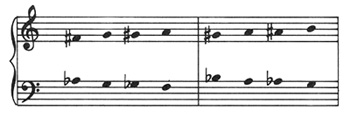
Much more indicative, however, is the textural delineation of upper and lower parts through the contrast or combination of legato and staccato. The resulting registral and textural contrasts represent aspects of keyboard exploitation that Debussy often pursued and which contribute greatly to the part differentiation that is sometimes found in the works that form the core of this study, the Preludes. It is in a number of the Preludes from both volumes that Debussy's contrapuntal or contratextural facility is perhaps most evident.
The Preludes
Like many composers, Debussy tried on new ideas through the medium of the piano, an instrument on which he was a virtuoso performer. It is easy to hear echoes of Chopin and other master keyboard composers from the past throughout Debussy's piano works. One can picture Debussy with an ear cocked sharply towards progressions like the following, which undoubtedly stirred his imagination and which occur frequently in his music.
Ex. 3. Chopin, Mazurka op. 17, No. 4.
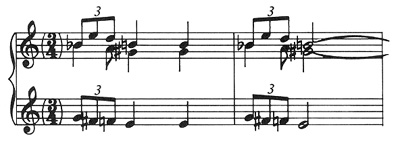
The artfully fashioned part-writing of Chopin, the crux of which lies in a capacity to create step and common tone connections in inner and bass parts, can be observed throughout Debussy's works, as well. It is nowhere more noticeable than in passages such as the opening of Danseuses de Delphes, the first Prelude from, Volume I (see Ex. 4[a]).
Ex. 4(a). Debussy, Danseuses de Delphes, Preludes, Vol. I, mm. 1-4.

Even such essentially chordal-styled passages as this reveal a modicum of contrapuntal interest in terms of inner-part integrity and outer-voice counter-directions. Like Chopin, Debussy often cements step triadic or seventh-chord movement with an inner-voice pedal. This can be observed in measures 3 to 4 of Ex. 4(a).
The details of Debussy's fastidious and impeccable voice-leading represent a study in themselves. For purposes of this paper they are acknowledged and assumed. Such preoccupation and skill undoubtedly form a basis for Debussy's ease of contrapuntal facility with which this paper is concerned and to which I would like to turn. The remainder of this study deals in the main with contrapuntal aspects of Preludes Nos. 2, 4, 6, 10, and 11 from Volume I and Nos. 5, 6 and 7 from the second volume.
Voiles has attracted considerable prior comment by virtue of its whole-tone pitch content and the inescapable pitch-set implications for such content. Among others, Perle3 has dealt with the set implications of Voiles. The piece also incorporates a number of contrapuntal procedures that appear subsequently in any number of Debussy's keyboard, vocal, and instrumental works. The first of these amounts to the combining of two related but texturally distinct motives. This occurs through measures 10 to 18, interrupted by moments of sustained or moving upper parts over a reiterated B-flat bass pedal. The combined motives are introduced together in measure 10, but thereafter are always stated in rhythmically staggered entrances. Within the harmonic field of the 0, 2, 4, 6, 8, 10 set of the piece the motives move free of any apparent consonant-dissonant constraints. The main differentiating basis lies in their independent rhythms and, importantly, their registral-timbral (textural) contrast. The upper motive, the germinal basis for the piece, projects parallel major thirds while the lower voice moves in either octaves (measures 10 to 13) or planed augmented triads (measures 15 to 19). Although harmonic interest increases as the passage is extended, the introduction of two-part counterpoint in measure 10 of Ex. 4(b) is predicated on an essentially linear association.
Ex. 4(b). Debussy, Voiles, Preludes, Vol. I, mm. 10-27.
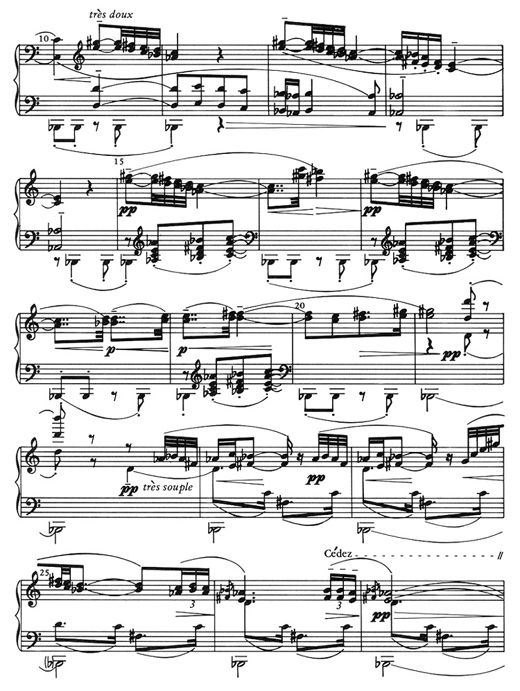
Accompanimental melodic ostinati are a major textural resource of Debussy; as such they provide a simple yet effective type of counterline against the more varied and interesting activity of other voices. A tenor ostinato is introduced in measure 22 of Voiles and restated for five measures. The ostinato (and supporting B-flat pedal) provides a complementary counterpoint against which a variant of the opening motivic material is developed. The contrast of rhythmic activity and relative tonal stability provided by the ostinato represents a satisfactory solution to the problem of extension posed herein. It is a solution that Debussy employed countless times and it is one that is essentially contrapuntal. It is also a solution that Stravinsky found highly acceptable as well.
Prelude No. 4 offers far more explicit harmonic variety and interest than does Voiles. Like Voiles, No. 4 (Les sons et les parfums tournent dans l'air du soir) incorporates motivic recurrence supported by a melodic ostinato in a simple two-part counterpoint.

The ostinato is prepared in the lower voice at measure 15 for two measures, then retained in the upper voice against a chordal main voice sounded below, beginning in measure 18. The main tonal connection relating the ostinato and main part is their common root pitch of C-sharp. Again the main tonal referent is that of a major-minor seventh chord (on C-sharp). As might be anticipated, the sonority has no functional value in a key. The differentiation of the two strands of activity is textural, the one consisting of single pitches the other treated in planed three-note sonorities consisting of diminished triads, major-minor sevenths (incomplete), and incomplete diminished seventh chords.
Prelude No. 6 (Des pas sur la neige) is a charming and expressive piece which in its own understated way provides an excellent glimpse of Debussian counterpoint. The piece is an uncluttered and economically unfolded succession of linear-harmonic events held together in part by a three-note pedal-ostinato that begins the piece alone (see Ex. 5).
Ex. 5. Debussy, Des pas sur la neige, Preludes, Vol. I, mm. 1-18.
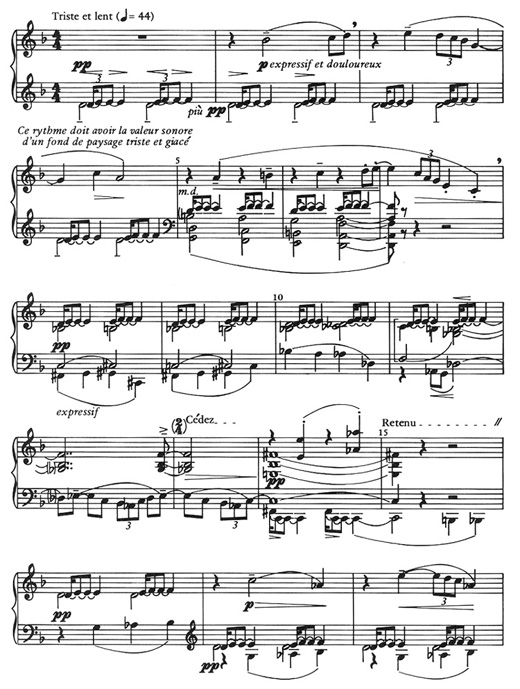
Measures 2 to 4 involve two-part counterpoint over the same tonic (D) pedal. The counterpoint is composed of three statements of the one-measure ostinato supporting the lovely, plaintive melody unfolding above it. Dissonance treatment is essentially linear and not predicated on any form of tertian complexity.
Rudimentary three-voice counterpoint forms the framework for the five-part texture begun at measure 5. Step contrary motion is the basis for the outer voice movement to a climactic ninth chord in measure 7, while inner voice independence is a product of the ostinato's placement in the tenor. Debussy's predilection for step part-movement is apparent again in measures 8 to 11. At this point the ostinato is given further prominence by appearing in the top voice with an accompanying bass counter-figure. Two ostinati envelop the D pedal for the three measures begun at measure 16. The main voice is derived from measures 2 to 4 of the opening; the texture consists of four rhythmically discrete parts whose meaning (the pedal excepted) is essentially melodic, harmonic interest being minimal. Again the movement of parts, intervallic and rhythmic, more suggests than defines explicitly fashioned and competing contrapuntal parts. But the rhythmic and contoural separation of parts is indicative herein of a linear impulse that far overshadows harmonic meaning or interest.
One measure after a Tempo, a brief phrase appears that provides still another glimpse of the simple and unadorned textures of the piece that consistently reveal an interplay of combined linear motives, figures, or subtle counter-movements of voices, typically contrasted in rhythm or articulation. Again the piece is extended by a process of texturally varying and migrating a few supple linear elements. That imitative processes play no role in the piece's growth in no way detracts from the fact that the extension of the piece is as much based on the composer's contrapuntal as harmonic inventiveness.
Prelude No. 10 (La Cathedrale engloutie), one of the most frequently performed, is predicated largely on the effects obtainable from layers of keyboard sonority consisting of a rich variety of harmonic combinations. These span the gamut from the dyads of the opening measures to the quartal-quintal combinations at measure 14 and include the extended tertian sonorities of measures 16 to 21. Chords constructed in fourths and seconds are prominent approaching the ends of both of the piece's main sections, measures 40 to 46 and 84 to 86. The piece's opening gesture,  is characterized by a rising major second and succeeding rising fifth. The melodic growth of the piece is based to a great extent on various transformations and restatements of that basic thematic gesture.
is characterized by a rising major second and succeeding rising fifth. The melodic growth of the piece is based to a great extent on various transformations and restatements of that basic thematic gesture.
Two intervallically related figures, shown in Ex. 6, are combined in counterpoint elaborating the II-V7 approach to tonic (E-flat) beginning ten measures from the end of Prelude No. 11.
Ex. 6. Debussy, La danse de Puck, Preludes, Vol. I, mm. 87-90.

The effect is one of added interest at a point in the piece (the coda) at which the tentative pace of the passage (Retenu) implies a compensatory addition to textural density, the piece as a whole being extremely sparse and thin texturally. Again the composer's unerring judgment and economy are evident in the suggestion of counterpoint introduced as opposed to an obvious contrapuntal development or extension.4 Previous passages in the same movement reveal several such touches, each representing a satisfying contrapuntal solution to the problems of form and texture posed by particular areas of the piece.
The fifth Prelude from Book Two is characterized by a refreshingly outgoing and lyrical melodic idiom, as signaled by the opening five measures (see Ex. 7).
Ex. 7. Debussy, Prelude no. 5, Vol. II, mm. 1-17.
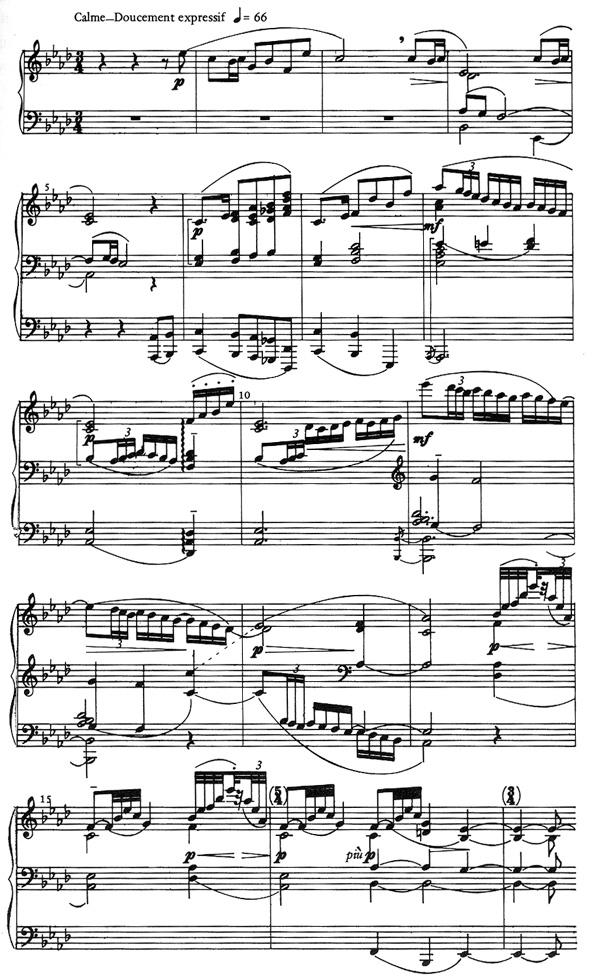
The elusive charm of the melody, like many Debussian melodic statements, is in part relatable to the tonal ambiguity of the line insofar as it gravitates towards the dominant, evading tonic emphasis almost entirely.
Although melodic interest is concentrated predominantly in one voice at a time throughout the piece as a whole, the piece's continuity and feeling of movement are integral products of voice-leading procedures that reveal the master's capacity for contrapuntal nuance and detail.
The simple expedient of contrary motion shapes the outer voices' contours in measures 6 and 7; the shift of dominant rhythmic activity from one to another register creates an illusion of imitation throughout the completion of the first section of the piece in measures 8 to 16. Subtle contrapuntal nuances that add measurably to the piece's interest and color can be observed, for example, in the G to F (octave) appoggiatura of measure 11 and the extended reiteration of the same gesture in measure 12. The coloratura-like sequence of the top voice at measures 19 to 20 is given contrapuntal support by the simple but expressive bass that moves in counter-step motion to the step progression F—E-flat—D-flat—C—B-flat of the top. A derivative motion appears in the lowest moving voice in measures 21 and 22 as a consequence of the quickened harmonic rhythm of the chords occurring in planing above it. Such details are in all likelihood more felt than heard.
The close of the Prelude is fashioned out of a simple V to I movement in A-flat, the fragmented melodic material coming from the piece's opening. The approach to V from IV (measures 6 to 8 from the end) is enhanced by ascending semitone movement from E to G stated in parallel octaves. This motion to the leading tone forms a simple counterpoint with the motivic fragments of the main voice. Once having arrived at the leading tone Debussy descends by step to E-flat (the dominant) before the arrival on tonic, predictably evading any direct connection of the leading tone with tonic.
Prelude No. 7 is a marvelous study in pianistic sonority and texture. It reflects Debussy's essential adherence to traditional sounds, i.e. triads, major-minor seventh chords, and a variety of complete and incomplete ninths juxtaposed in non-functional relations, especially second and third relations. The piece's harmonic organization can be viewed as an elaborated movement from V to I in F-sharp major.
The impact of the work is fundamentally harmonic, and like most of Debussy's compositions sonority, color, registral contrasts, etc. constitute the points of major focus and attraction. Melody per se appears to play the role more of connecting and arising from chord succession than of leading or motivating harmonic choice and direction. Rudolph Reti alludes to the melodic-harmonic aspects of Debussy's music in stating5, "However, to understand Debussy's full achievement in this sphere, one must not forget that his compositions are not merely successions of homophonic melodies, as were (at least as far as our knowledge goes) those old folk tunes, but that his basic melodic shapes sound within a complicated web of passages, contrapuntal garlands and harmonies of various types. . . ."
One can take this line of thinking one further step and conclude that in compositions such as this Prelude there are passages in which melody and harmony are virtually one, and the distinction between them is moot. Measures 28 to 31 are a good illustration of such pan-melodic or pan-harmonic passages; all voices are of co-equal melodic-harmonic significance and there is no value in differentiating between melody and harmony as such in traditional terms of main voice and accompaniment or line and counterline. Linearity is a result of voice-leading and chords are as much a product of multiple intervallic melodic reinforcement as they are vertical sonorities in their own right. Extending the same intervallic vertical distance between voices minimizes harmonic interest as much as the melodic duplication of parts minimizes their contrapuntal independence.
Related but not identical to such passages are those such as the phrase begun in measure 13. The passage projects homorhythmic relations of voices, but an element of counterpoint occurs in the counter-movement between top and "tenor":
Ex. 8(a). Debussy, Prelude No. 7, Vol. II, m. 13.
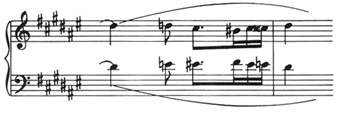
A more distinct contrapuntal relation of parts is introduced at measure 16 in the form of principal and subordinate motives:
Ex. 8(b). Debussy, Prelude No. 7, Vol. II, mm. 16-19.
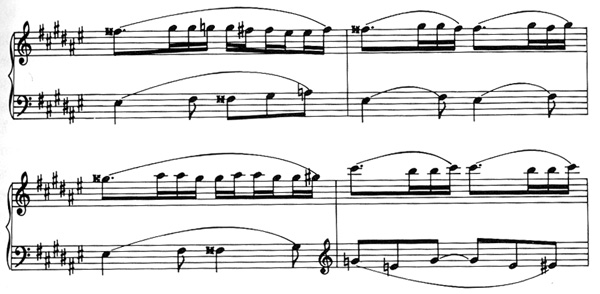
The contrary motion of the passage typifies Debussy's careful control of linear pattern. The absence of harmonic change reflects a more pointedly contrapuntal emphasis. The counterpoint is enveloped by C-sharp pedals in the top, bass, and middle registers.
A final illustration from the same Prelude combines the harmonic parallelism of measure 29 with an element of contrapuntal differentiation similar to that noted previously in measure 16. Measures 21 to 24 involve three levels of activity, a bass level of pedals, a middle level of planed trichords (actually incomplete major-minor sevenths), and a top stratum of dyads with outer part doublings.
Ex. 9. Debussy, Prelude No. 7, Vol. II, mm. 22-24.
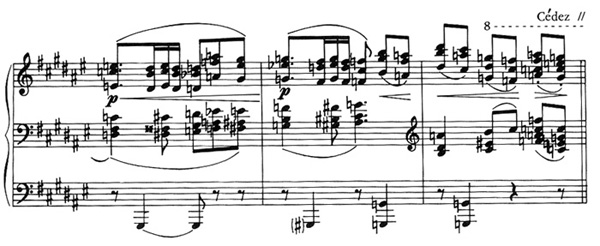
Again it is easy to observe a number of compositional constraints imposed by the composer which contribute markedly to the balance and coherence of the writing; the stability of a pedal, the dominance of step-motion in moving parts, step and contrary step-motion predominating, and the rhythmic individuality of each of the three strata.
Passages such as the one to follow, which involve a skillful integration of both linear and harmonic materials, knowledgeably deployed for the orchestra, are as indicative as any of the composer's craft and economical use of materials. The impact of such passages on Debussy's immediate successors, such as Stravinsky and Bartok, as observed in compositions such as The Rite of Spring, Bartok's Two Portraits for Orchestra or First String Quartet, seems apparent. Many of Bartok's later works such as the Sonata for Two Pianos and Percussion continue to reflect in more complex ways patterns and textures similar to those found in the Preludes. It is perhaps more in the invention of manipulative processes than in the raw materials themselves that Debussy's impact was most felt. There is no question but that an ear for contrapuntal detail as well as sonority helped channel the genius for musical invention that inevitably signals his music.
A number of linear or contrapuntal aspects of Debussy's Preludes have been cited in the preceding discussion. These facets of Debussy's style constitute details, for the most part, of a technique and craft developed within the general cast of homophony and harmonically conceived textures. While the composer may have shunned contrapuntal devices he clearly displayed awareness of contrapuntal principles of voice-leading, counter-rhythms, and spacing. His inventiveness of spatial arrangements is itself sufficient to warrant recognition as a craftsman of first rank. Perhaps Debussy's craft is most admired as employed in his orchestral works. Although the focus of this study has been piano music it is worth noting that, like most composers, Debussy followed through in his orchestral music on the promises of his keyboard works so that a remarkable consistency of approach and process can be observed between the two genres. This can be confirmed by a glance at the opening pages of La Mer, 1905, measures 6 to 22 of which are quoted below (see Ex. 10).
Ex. 10. Debussy, La Mer, mm. 6-22.
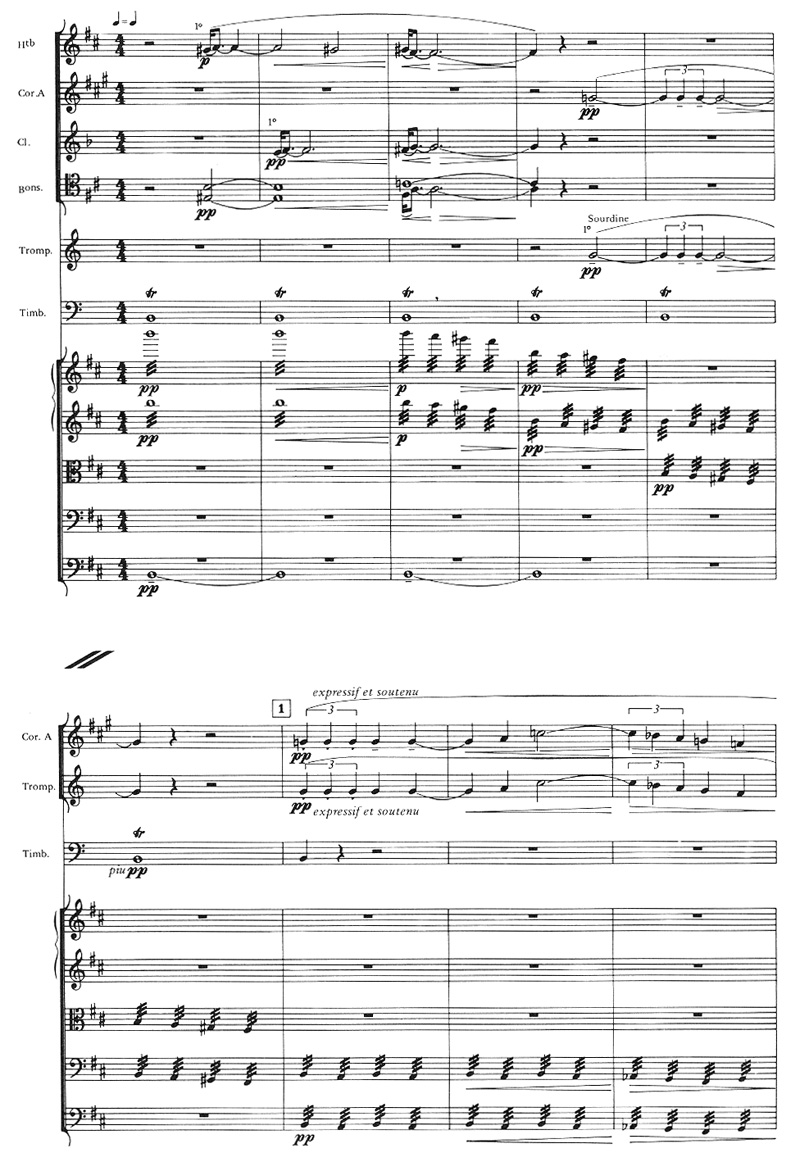
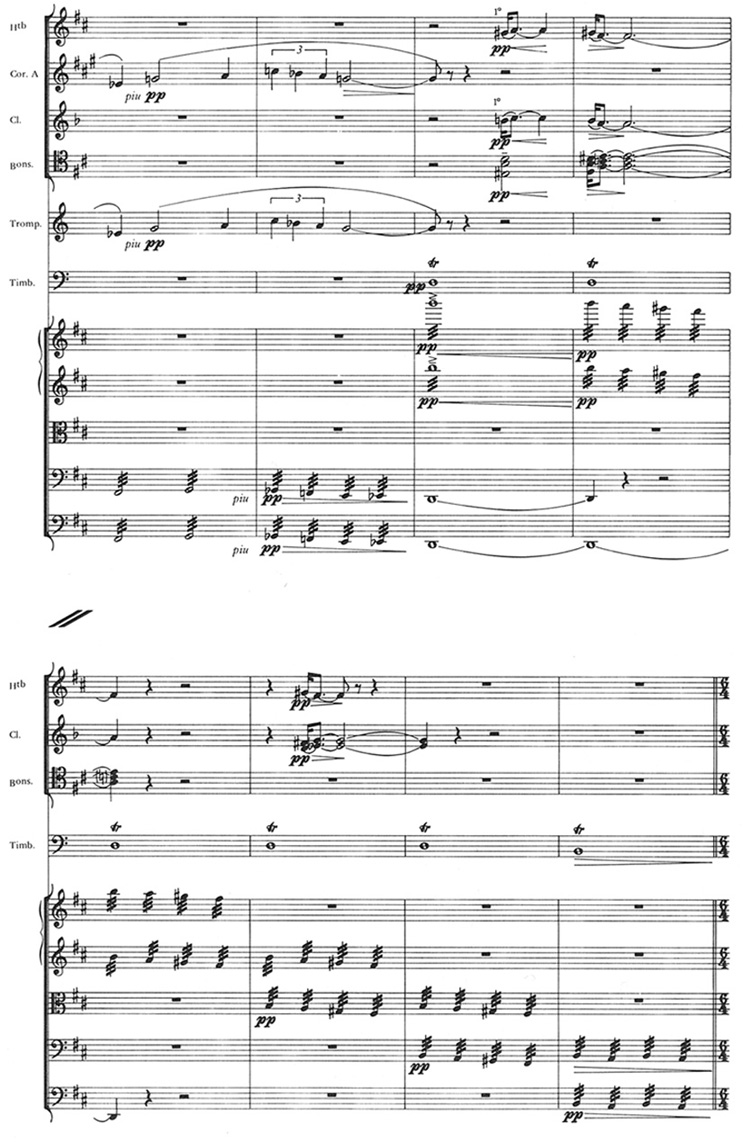
Three linear elements comprise the basis for the expository passage; they consist of the following:

Typically, one of the elements, in this case the one labeled (c), is treated as an ostinato in various shifting registers. The other two elements are juxtaposed in counterpoint against the ostinato. The texture is thin and the linear components are quite transparent. The rhythmic and timbral separation of parts as observed in the composer's scoring of each motive, motive (a) scored for oboe and/or clarinet, motive (b) scored for the combination of muted trumpet and English horn, and the ostinato figure treated by shifting pairs of strings, contributes effectively to the delineation of the three elements. The timpani and periodic three-note chords in the bassoons provide a soft cushion for the evolving linear gestures above.
Subsequent passages in La Mer reveal numerous reoccurrences of these and similar processes. This is especially true in the third movement, Dialogue du vent et de la mer.
That Debussy will ever be acknowledged as a contrapuntist is very much in doubt; our biases towards closed traditional descriptions of what constitutes counterpoint will see to that. However, given the cliches and accepting traditional definitions of counterpoint, homophony, and other terms, there may be enough latitude for a more expanded view of the range of style and mastery of craft that are clearly apparent in the works of Debussy, the reluctant contrapuntist.
Notes
1See H.H. Stuckenschmidt, Music in the Twentieth Century, p. 5.
2Claude Debussy, Letters a son editeur (Paris: Durand, 1927), p. 179, in Composers on Music, translated by Sam Morgenstern, ed. (New York: Pantheon Books, 1956), pp. 324-25.
3George Perle, Serial Composition and Atonality, p. 37.
4Leading tone to tonic motion by rising half step is rarely used, for example.
5Rudolph Reti, Tonality in Modern Music (New York: Collier Books, 1962), p. 40.


